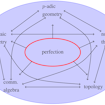CCA’s Blakesley Burkhart Awarded Annie Jump Cannon Award in Astronomy

The American Astronomical Society has awarded its 2019 Annie Jump Cannon Award in Astronomy to Blakesley Burkhart, an associate research scientist at the Flatiron Institute’s Center for Computational Astrophysics.
The prize honors “outstanding research and promise of future research by a postdoctoral woman researcher,” according to the AAS. It is named in honor of Annie Jump Cannon, who was instrumental in the development of the modern star classification system.
“It’s a great honor, especially considering that this is the oldest AAS award and it includes so many brilliant scientists in its lineage,” Burkhart says. “The Cannon prize has been around since its inception by Annie Jump Cannon herself in 1934, and I’m thrilled to have received it.”
The society announced the award January 8, 2019, in Seattle at its semiannual meeting. The announcement highlighted Burkhart’s leadership in the study of magnetic turbulence in the universe. Her research interests include the solar wind, the material that fills the space between stars, and the hot ionized gas in galaxy clusters. In her work, she employs innovative techniques to compare observational data with numerical simulations, guided by analytic theory.
Burkhart joined the Flatiron Institute in August 2018. She received her Ph.D. in astronomy at the University of Wisconsin-Madison and was an Einstein Fellow and a joint ITC/SMA Fellow at the Harvard-Smithsonian Center for Astrophysics in the Institute for Theory and Computation. In September, she will additionally assume an assistant professorship at Rutgers University.
“We were delighted when Dr. Burkhart decided to join the CCA and Rutgers,” says Rachel Somerville, co-leader of CCA’s galaxy formation groups and the George A. and Margaret M. Downsbrough Chair in Astrophysics at Rutgers University. “Her work cuts across different areas of astrophysics and has the potential to connect different communities. She is very deserving of this recognition, which some of the top scientists in our field have received in the past.”


